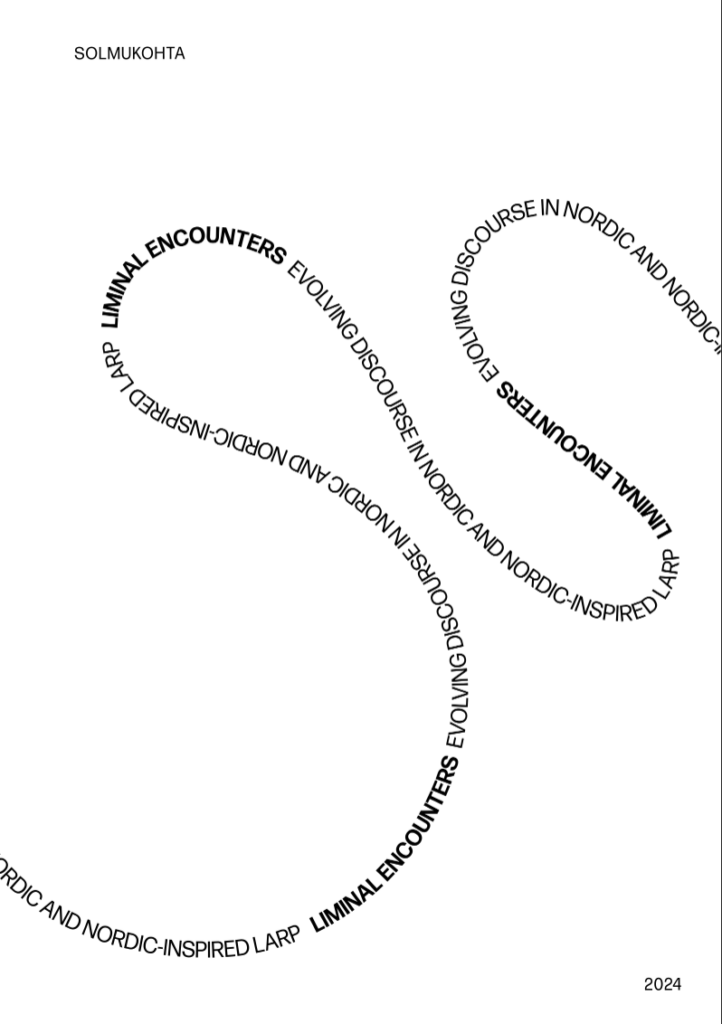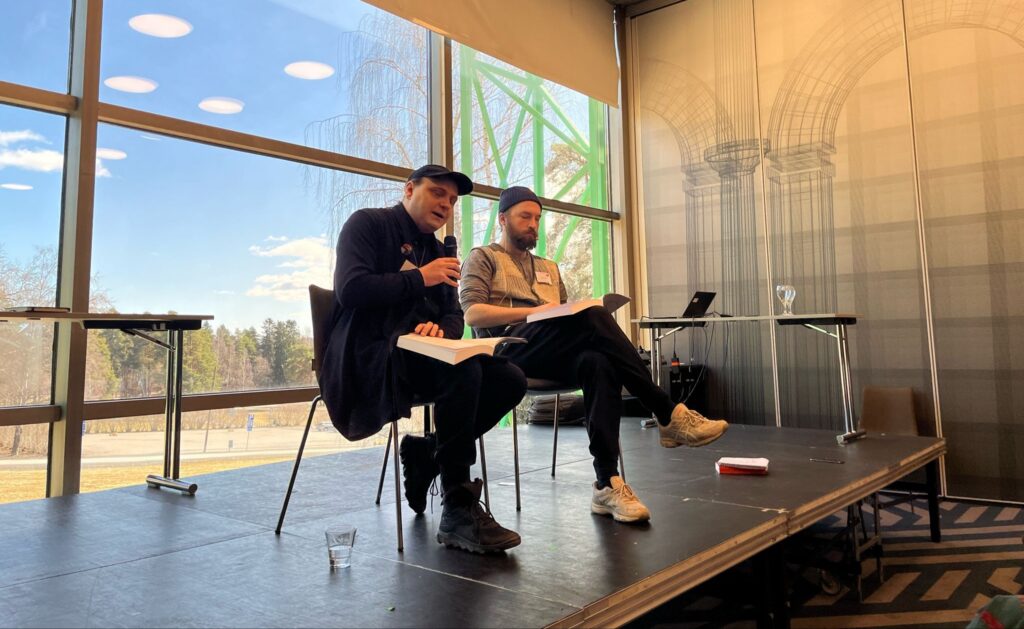
The annual Nordic live action role-play conference Knutpunkt/Solmukohta usually comes with an anthology on different aspects of larp. This year’s title was LIMINAL ENCOUNTERS: Evolving Discourse in Nordic and Nordic-inspired Larp and it was edited by Kaisa Kangas and her team. There are many good contributions to this year’s book. I can specifically recommend “The Manifesto of Playing to Live Elsewise” by Maiju Tarpila and “Readdressing Larp as Commodity: How Do We Define Value When the Customer Is Always Right?” by Usva Seregina. Both these text dig deeper in the relation between larp and consumer capitalism.
I had the pleasure to co-write a text and present it at the conference together with Andrea Nordwall.

Against Design
Larp in general, and Nordic style larp in particular, is often claimed to be an artistic practice, a frontier of participatory arts. However, discourse on larp by larp organizers, larp participants and game studies researchers has, in recent years, started to frame larp making primarily as a design practice. By that logic larps are now designed by larp designers using larp-specific participatory interaction design methods. Discussions on these design methods have become the mainstay of larp conferences such as Knutpunkt/Solmukohta. Let’s discuss what this hegemony of design thinking does to our practice.
The overall project of design thinking is constructive. Design has lowered the thresholds of participation as well as enabled and structured larp organizing. In the best case, larp designers evaluate best practices and share methods. Although every step in this direction seems like a small success of self-understanding and self-improvement, we argue that the long-term consequences do not necessarily benefit larp as a culture nor as an artistic form. The current hegemony of larp as design does the groundwork for an ongoing reification and commodification of larp. Design transforms larp participants into larp consumers.
New larp projects are now pitched to participants with methods catering to various larp audiences (or rather intended target groups). Post-mortems of past projects serve the function of user experience (UX) evaluation examples to optimize the design of future projects. The design methods are reevaluated based on past successes in relation to informally segmented target groups (such as fantasy-chillout, dystopian-play-to-lose, or post-apocalypse-over-the-top larp consumers), combining setting with interaction style to form specific and recurring audiences. These target groups can then be matched to tried and tested larp design methods to successfully form an iterative and recursive feed-forward UX loop. In practice, this leads to repeating ideas and design elements that have proven to be successful, at the expense of new innovation.
In their marketing, larps can “attach” themselves to commercially successful and well-known IPs and franchises to pitch projects with similar names, using brand recognition to drive participance, forming a secondary volunteer-run streaming service experience. The success of this strategy indicates an environment where even the overall set and setting for a larp is purposefully used as a design method to drive interest in and communicate intended participation. Adopting commercially successful mass media culture is the optimal strategy for producing predictable participance.
There was a time when mass media enviously glanced at the rich culture and engagement surrounding Nordic larp. By now, the roles are reversed. When larp designers take turns riding on various commercial successes in mass media, larp becomes a cecum of Hollywood film and streaming culture. Such an approach would be highly unusual in artistic fields, where originality merits artistic value.
We argue that larp as a form is being restricted by its own success as a participatory design practice and that innovation in larp is over (other than sporadic and local). We see several reasons why larp as design practice hampers larp innovation.
Firstly, design thinking avoids conflict at all costs to deliver a product. Any kind of conflict or disagreement is considered a failed interaction design. But culture can be nurtured by conflict, and we would argue that Nordic larp developed through cultural and subcultural clashes, not through consensus-based “everything is okay as long as you know what you want” design thinking. Bring back dialectics; it’s not smooth, but it’s also not harmful.
We are concerned that larp as a field at this point is emulating some of the worst aspects of experience design commodity culture: start-up ambitions among organizers (including burn-out syndrome) and reification of participants’ social interactions: social interaction becomes a “product” that is delivered by the larp through strategic employment of larp design methods.
The idea of clarity of purpose that design brings makes larp a “readerly” practice – a practice where interpretation (and interaction) is “prepared” for the participant, rather than a “writerly” or artistic-oriented practice, open for the plurality of interpretation (and potential conflict). Clarity of interpretation is optimal for designing and delivering predictable and serviceable interaction for a defined target group. This results in predictable and shallow cultural practices and artifacts.
Remember, there are many ways to make larps. Norwegians use the word lage, a verb that could be utilized for larp making as well as for cooking a soup. Larps can be written, created, organized, dreamt up, or they can be born from artistic practice. We want to encourage a plurality of ways of creating larp.
Think about larp as a culture. It has been said that design is “the opposite of tradition.” Then maybe it’s time to value some of our subcultural traditions, the mutual knowledge of gathering and making stories come alive through our community. Here, we have to understand the limits of design thinking. For example, one of the key features of Nordic larp is trust. We have developed trust in our subculture by nurturing it for many years and events, to the point where we can say trust is part of our tradition. This makes some scenarios possible that would otherwise not be possible. However, you can not replace the tradition of trust by design. The harder you try, the further you fall when something goes wrong.
We argue that larp should not be reduced to a streamlined, well-designed experience product, but rather nurture an aesthetic field, an artistic form in dialogue with the participants as well as the culture at large. The reason larp fails to claim a culturally relevant position is because the primary focus on design optimization reduces our capacity to form an aesthetic or artistic field in dialogue with the wider culture. As an artistic form, larp makers should look for autonomy and integrity in our practice.
Stop using experience product delivery as the primary factor when evaluating larp projects. Instead, focus on how it innovates the form and how it can reshape culture by doing so. The latter is not necessarily realized through “good design”, but through good art.
Know that there is a difference between feedback and critique. We know how to give and get the former, not the latter. When engaging in society, larp will become criticized for how it, as a participatory form, approaches important issues. Be ready for, welcome, and enable criticism, not just on how well participatory methods worked out or whether the experience delivered quality time, but on how the form of larp itself can interpret and address cultural issues relevant to society in a wider context. Instead of targeting cultural and societal matters, larp has become a recursive product design improvement loop that is increasingly optimized for a decreasingly creative field.
If we consider larp-making as an artistic creation process, it does not necessarily involve problem-solving or a user-centered approach. Larps can happen through community building, collaborative creation, or even serendipity.
Author bios
Andrea Nordwall is a long-time larper, with a background in art and theatre and a Master’s degree in interaction design. She produced the first commercially available blackbox larp Force Majeure with Gabriel Widing in 2001 and co-authored Deltagarkultur in 2009 with the now defunct participatory art collective Interacting Arts.
Gabriel Widing is an artist and game designer, interested in performance, play and participation. His recent works includes the mobile based scenarios Ekstasis made with Nyxxx as well as Mobilized and Inferno Speeddate made with Nea Landin. At the moment he is working on a performance based on medieval mystic Hadewijch’s poem Love’s Seven Names in collaboration with Áron Birtalan.